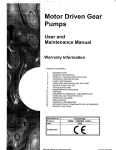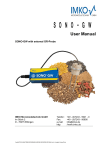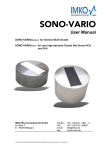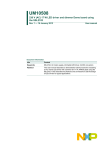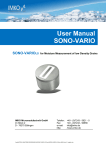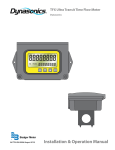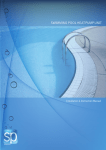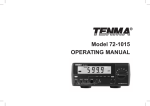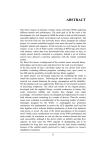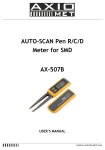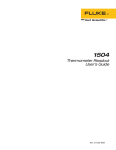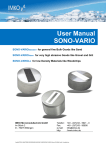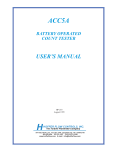Download Field Mounted Rate/Totalizer USER`S MANUAL
Transcript
MODEL 302di Field Mounted Rate/Totalizer USER’S MANUAL HP-295 November 2002 107 Kitty Hawk Lane, P.O. Box 2145, Elizabeth City, NC 27906-2145 800-628-4584 252-331-1997 FAX 252-331-2886 www.hofferflow.com E-mail: [email protected] NOTICE Hoffer Flow Controls, Inc. makes no warranty of any kind with regard to this material, including, but not limited to, the implied warranties of merchantability and fitness for a particular purpose. This manual has been provided as an aid in installing, connecting, calibrating, operating, and servicing this unit. Every precaution for accuracy has been taken in the preparation of this manual; however, Hoffer Flow Controls, Inc. neither assumes responsibility for any omissions or errors that may appear nor assumes liability for any damages that result from the use of the products in accordance with information contained in the manual. HOFFER FLOW CONTROLS' policy is to provide a user manual for each item supplied. Therefore, all applicable user manuals should be examined before attempting to install or otherwise connect a number of related subsystems. During installation, care must be taken to select the correct interconnecting wiring drawing. The choice of an incorrect connection drawing may result in damage to the system and/or one of the components. Please review the complete model number of each item to be connected and locate the appropriate manual(s) and/or drawing(s). Identify all model numbers exactly before making any connections. A number of options and accessories may be added to the main instrument, which are not shown on the basic user wiring. Consult the appropriate option or accessory user manual before connecting it to the system. In many cases, a system wiring drawing is available and may be requested from Hoffer Flow Controls. This document contains proprietary information, which is protected by copyright. All rights are reserved. No part of this document may be photocopied, reproduced, or translated to another language without the prior written consent of Hoffer Flow Controls, Inc. HOFFER FLOW CONTROLS’ policy is to make running changes, not model changes, whenever an improvement is possible. This affords our customers the latest in technology and engineering. The information contained in this document is subject to change without notice. THIS WARRANTY IS EXPRESSLY IN LIEU OF ALL OTHER WARRANTIES, EXPRESSED OR IMPLIED, INCLUDING ANY IMPLIED WARRANTY OF MERCHANTABILITY OR FITNESS FOR A PARTICULAR PURPOSE. HFC SHALL NOT BE LIABLE FOR ANY LOSS OR DAMAGE RESULTING, DIRECTLY OR INDIRECTLY, FROM THE USE OR LOSS OF USE OF THE GOODS. WITHOUT LIMITING THE GENERALITY OF THE FOREGOING, THIS EXCLUSION FROM LIABILITY EMBRACES THE PURCHASER'S EXPENSES FOR DOWNTIME OR FOR MAKING UP DOWNTIME, DAMAGES FOR WHICH THE PURCHASER MAY BE LIABLE TO OTHER PERSONS, DAMAGES TO PROPERTY, AND INJURY TO OR DEATH OF ANY PERSONS. HFC NEITHER ASSUMES NOR AUTHORIZES ANY PERSON TO ASSUME FOR IT ANY OTHER LIABILITY IN CONNECTION WITH THE SALE OR USE OF HFC'S GOODS, AND THERE ARE NO ORAL AGREEMENTS OR WARRANTIES COLLATERAL TO OR AFFECTING THE AGREEMENT. PURCHASER'S SOLE AND EXCLUSIVE REMEDY IS THE REPAIR AND/OR REPLACEMENT OF NONCONFORMING GOODS AS PROVIDED IN THE PRECEDING PARAGRAPHS. HFC SHALL NOT BE LIABLE FOR ANY OTHER DAMAGES WHATSOEVER INCLUDING INDIRECT, INCIDENTAL, OR CONSEQUENTIALDAMAGES. HFC 9907 Limited Warranty POLICY FOR Hoffer Flow Controls HOFFER FLOW CONTROLS, INC. ("HFC") warrants HFC's Precision Series and API Series of turbine flowmeters to be free from defects in material and workmanship under normal use and service, only if such goods have been properly selected for the service intended, properly installed and properly operated and maintained as described in the turbine flowmeter manual. Reference "turbine flowmeter manual" for specific details. This warranty shall extend for a period of five (5) years from the date of shipment to the original purchaser and covers the Precision Series and API Series of flowmeters All other HFC products carry a one (1) year warranty. This warranty is extended only to the original purchaser ("Purchaser"). Purchaser's sole and exclusive remedy is the repair and/or replacement of nonconforming goods as provided in the following paragraphs. In the event Purchaser believes the Hoffer product is defective, the product must be returned to HFC, transportation prepaid by Purchaser, within the appropriate warranty period relative to the product. If HFC's inspection determines that the workmanship or materials are defective and the required maintenance has been performed and, has been properly installed and operated, the product will be either repaired or replaced, at HFC's sole determination, free of additional charge, and the goods will be returned, transportation paid by HFC, using a transportation method selected by HFC. Prior to returning the product to HFC, Purchaser must obtain a Returned Material Authorization (RMA) Number from HFC's Customer Service Department within 30 days after discovery of a purported breach of warranty, but not later than the warranty period; otherwise, such claims shall be deemed waived. See the Return Requests/inquiries Section of this manual. If HFC's inspection reveals the Hoffer product to be free of defects in material and workmanship or such inspection reveals the goods were improperly used, improperly installed, and/or improperly selected for service intended, HFC will notify the purchaser in writing and will deliver the goods back to Purchaser upon receipt of Purchaser's written instructions and agreement to pay the cost of transportation. If Purchaser does not respond within thirty (30) days after notice from HFC, the goods will be disposed of in HFC's discretion. HFC does not warrant the product to meet the requirements of any safety code of any state, municipality, or other jurisdiction, and Purchaser assumes all risk and liability whatsoever resulting from the use thereof, whether used singlely or in combination with other machines or apparatus. This warranty shall not apply to any HFC product or parts thereof, which have been repaired outside HFC's factory or altered in any way, or have been subject to misuse, negligence, or accident, or have not been operated in accordance with HFC's printed instructions or have been operated under conditions more severe than, or otherwise exceeding, those set forth in the specifications. FOR NON-WARRANTY REPAIRS OR CALIBRATIONS, consult HOFFER FLOW CONTROLS for current repair/calibration charges. Have the following information available BEFORE contacting HOFFER FLOW CONTROLS: 1. P.O. number to cover the COST of the repair/calibration, 2. Model and serial number of the product, and 3. Repair instructions and/or specific problems relative to the product. HFC 9907 CONTENTS 1. Introduction---------------------------------------------------------------- 1 1-1 Model Number Designation ------------------------------------------2 1-2 Intrinsic Safety Considerations---------------------------------------4 2. Specifications -------------------------------------------------------------- 6 2-1 General -------------------------------------------------------------------6 2-2 Battery Powered Version ----------------------------------------------6 2-3 Loop Powered 4-20mA Output Version-----------------------------6 2-4 DC Power/Alarm Version ---------------------------------------------7 2-5 Physical ------------------------------------------------------------------7 3. Operation------------------------------------------------------------------- 9 3-1 Display -------------------------------------------------------------------9 3-1-1 Front Panel Operation -------------------------------------------9 3-2 Test Mode-------------------------------------------------------------- 10 3-3 Filtering ---------------------------------------------------------------- 10 3-4 Calculation of Rate and Total--------------------------------------- 12 3-5 Total Conversion------------------------------------------------------ 13 3-6 Non-linearity Correction Feature ---------------------------------- 14 4. Configuring ---------------------------------------------------------------15 4-1 Configuration Steps -------------------------------------------------- 16 4-2 Example ---------------------------------------------------------------- 20 5. Versions--------------------------------------------------------------------21 5-1 Battery Powered Version -------------------------------------------- 21 5-2 4-20mA Output with Alarms Version----------------------------- 22 5-3 DC POWER VERSION --------------------------------------------- 24 6. Flowmeter Input ---------------------------------------------------------27 7. Intrinsic Safety Connections-------------------------------------------31 7-1 Coils--------------------------------------------------------------------- 31 7-2 Simple Apparatus ----------------------------------------------------- 31 7-3 Alarm Outputs--------------------------------------------------------- 33 8. Installation ----------------------------------------------------------------35 8-1 Wall Mounting -------------------------------------------------------- 35 8-2 Panel Mount Version------------------------------------------------- 36 8-3 Removing The Front Panel------------------------------------------ 37 8-4 The Main Electronics ------------------------------------------------ 39 8-5 Wiring ------------------------------------------------------------------ 40 8-6 Terminal Designations ----------------------------------------------- 40 Model 302di HP-295 Model 302di HP-295 Introduction 1 1. INTRODUCTION The Model 302d Rate-Totalizer is a microprocessor-based instrument which accepts frequency or pulse inputs from a wide range of flowmeters. The instrument displays Flowrate, a Resettable Total, and an Accumulated Total directly in engineering units. The instrument is compatible with a wide range of flowmeters. Links on the input board enable the circuit to be configured for millivolt signals, reed switches, pulse trains, and most other signal types. Three different versions of the instrument are available: 1. 2. 3. A Battery Powered version with no outputs A Loop Powered version with 4-20mA output and alarms/pulse output. A DC Powered version with either high and low flow alarms or low flow alarm and pulse output The Model 302d is fully configurable with K-factors, decimal point positions, filter constants, and timebase being programmed via the front panel switches. This instrument conforms to the EMC-Directive of the Council of European Communities 89/336/EEC and the following standards: Generic Emission Standard EN 50081-1 Residential, Commercial & Light Industry Environment. Generic Emission Standard EN 50081-2 Industrial Environment. Generic Emission Standard EN 50082-1 Residential, Commercial & Light Industry Environment. Generic Emission Standard EN 50082-2 Industrial Environment. In order to comply with these standards, the wiring instructions in Section 8.5 must be followed. Model 302di HP-295 2 Introduction 1-1 Model Number Designation MODEL 302di DC POWERED RATE/TOTALIZER, INTRINSICALLY SAFE (TO BE USED ONLY WHEN APPROVALS ARE REQUIRED) MODEL 302di-( A )- ( B )-( C ) TYPE OF MOUNTING POWER OPTIONS OPTIONS TYPE OF MOUNTING MODEL 302di-( A )-( )-( ) OPTION ( A ) (1) PANEL MOUNT (2) WALL MOUNT WITH CABLE GLANDS (3) EXPLOSION-PROOF WITH 1" BOTTOM MOUNT WITH UNION (SEE NOTE 5) (4) 1" NPT BOTTOM MOUNT WITH UNION (SEE NOTE 5) (5) 1" NPT REAR MOUNT WITH UNION (SEE NOTE 5) (6) 2" GALVANIZED PIPE BRACKET (SEE NOTE 6) POWER OPTIONS MODEL 302di-( )-( B )-( ) OPTION ( B ) (O) LITHIUM BATTERY (INTRINSICALLY SAFE) (3L) (4L) NOTE: 9-28 VDC POWER WITH LO ALARM, AND HI ALARM OR AN OPEN COLLECTOR OPTO ISOLATED PULSE OUTPUT (USER SELECTABLE). MEMORY BACKUP WITH LITHIUM BATTERY. LOOP POWERED WITH LO ALARM, AND HI ALARM OR AN OPEN COLLECTOR OPTO ISOLATED PULSE OUTPUT (USER SELECTABLE). INTRINSICALLY SAFE WITH BARRIER IN SAFE AREA. MEMORY BACKUP WITH LITHIUM BATTERY. SPECIFY DC POWER (OPTION 3) WHEN USING A REDI-PULSE COIL INPUT. BATTERY VERSION IS NOT AVAILABLE FOR USE WITH THE RED-PULSE COIL. LOOP POWERED (OPTION 4L) MAY BE SPECIFIED, HOWEVER,REDI-PULSE COIL MUST HAVE AN ISOLATED DC POWER SUPPLY. Model 302di HP-295 Introduction OPTIONS MODEL 302di-( )-( )-( C ) OPTION ( C ) (CE) INTERFERENCE CE COMPLIANCE WITH CSA APPROVAL (CEN) CENELEC, NRTL/C AND SAA APPROVAL (CE/CEN) WHEN BOTH APPROVALS REQUIRED (2) 10 POINT LINEARIZATION NOTES: 1. 2. 3. 4. 5. 6. 7. MUST USE ISM INTRINSICALLY SAFE MAGNETIC COIL FOR INTRINSICALLY SAFE SYSTEM. STANDARD COILS ARE SUITABLE FOR SYSTEMS THAT DO NOT REQUIRE INTRINSICALLY SAFE. LCD DISPLAY: 7 DIGIT 0.4" (10MM) TOTAL CONTINUOUSLY DISPLAYED 5 DIGIT 0.33" (85MM) CONTINUOUSLY DISPLAYED RATE, ACCUMULATED DISPLAYED BY KEY DEPRESSION BATTERY LIFE FULL 2 YEARS IF CONTINUOUSLY USED. 1" RISER IS REQUIRED ON TURBINE FOR MOUNTING OPTION (3), (4) OR (5). A GALVANIZED METAL BRACKET ENABLES THE UNIT TO BE ATTACHED TO A 2" VERTICALOR HORIZONTAL PIPE. 10 POINT LINEARIZATION MUST BE CALLED OUT. APPROVALS OPTIONAL APPROVALS UNDER (CEN) OPTION INTRINSICALLY SAFE WATER TIGHT TO IP67 (NEMA 4X) The Model 302di Model 302di HP-295 3 4 1-2 Introduction Intrinsic Safety Considerations The Model 302d is certified for use in hazardous areas and has both CENELEC and CSA C/NRTL approvals. The Model 302d certification details are: CENELEC Approval: Type of Protection: Group: Temperature Class: Kema 98.E.1873. Ex ia. IIB. T4 at ambient temperature of 60°C. CSA C/NRTL Approval File Number: Type: LR 104 840-5. Class 1, Groups C and D When installing in hazardous areas, the instrument must be installed according to the guidelines in Section 6 and in accordance with standards for wiring and installation in hazardous areas. Flowmeter Inputs Entity Parameters on the flowmeter input enable connection to a wide range of approved sensors. Input Parameters are: Ui = 24V Ii = 20mA Pi = 320mW The internal capacitance and inductance seen on these terminals is 0.002 µF and 0 mH. Output Parameters are: Uo = 10.0V Io = 9.0mA Maximum allowed external capacitance is 60 µF. Maximum allowed external inductance is 1.5H. Model 302di HP-295 Introduction 4-20mA/DC Power The input can be connected to IS circuits with the following maximum values: Ui = 28V Ii = 93mA Pi = 653mW. The internal capacitance and inductance seen on these terminals is 0.1 µF and 0 mH. Relay Outputs The output can be connected to IS circuits with the following maximum values: Ui = 28V Ii = 93mA Pi = 653mW. The internal capacitance and inductance seen on these terminals is 0.1 µF and 0 mH. Model 302di HP-295 5 6 Specifications 2. SPECIFICATIONS 2-1 General Display: Resettable Total: Accumulated Total: Rate: K-factor: Decimal Points: Timebase: Frequency Range: Signal Type: 2-2 Battery Powered Version Type: Battery Life: 2-3 LCD, continuously powered 7 digits with 10mm (0.4") high digits. Resettable from front panel. Displayed when the ACCUM TOTAL button is pressed. 4½ digits with 8.5mm (0.33") high digits. The pulses per unit of measure (e.g. pulses/gallon) is configurable in the range 0.000001 to 999,999. Decimal Point positions are fully configurable for both rate and total. Rate can be displayed in units per second, minute, hour, or day. 0.01Hz to 10kHz. Link settable for Sinewave (15mV P-P minimum), Open Collector, Reed Switch, or Pulse. Two lithium battery packs. 5 years typical. Loop Powered 4-20mA Output Version Scale: Resolution & Linearity: Accuracy: Update Time: Connection: Loop Power Supply: Supply Backup: Model 302di The 4mA and 20mA points are configurable. 0.05% of span. 0.05% of span @ 25ºC. 0.1% (typ) of span, full temperature range. 0.5 seconds. Two wire. 9-28 volts. Lithium battery. HP-295 Specifications 2-4 DC Power/Alarm Version Outputs: Switching Power: DC Power Input: Supply Backup: Pulse Duration: 2-5 7 Two open collector outputs suitable for driving DC solenoids or external relays. The outputs provide high and low flow alarms or low flow alarm and pulse output. 200mA 30VDC maximum. 9-28 Volt at 4mA maximum. Lithium battery. 1ms if CAL0 = 2 (unscaled pulse output) If CAL0 = 1 (scaled pulse output) automatically adjusts to the output frequency: a. 1ms output > 50Hz b. 10ms output = 5 … 50Hz c. 100ms output < 5Hz Physical Temperature: Dimensions: Protection: Cable Entry: Wall Mounting: Pipe Mounting: Turbine Meter Adapter: Panel Mounting: Model 302di Operating: -20°C to 60°C. 97mm (3.8") high x 150mm (5.9") wide x 41mm (1.6") deep (cable glands not included). Sealed to Nema 4X or IP67 standards. By cable glands. Universal Mounting Bracket supplied (Standard). A galvanized metal bracket is available which enables the Model 302d to be attached to a 2" vertical or horizontal pipe. An optional mounting stem is available for mounting the Model 302d directly on turbine flowmeters which have a 1" MNPT boss. Supplied with mounting brackets. Terminals accessible from the rear. Not watertight. Cutout: 141mm (5.6”) wide x 87mm (3.4”) high. HP-295 8 Operation 3. OPERATION The Model 302d Rate Totalizer accepts a frequency or pulse input from a wide range of flowmeters. The instrument is fully configurable with all operating parameters and calculation constants configurable from the front panel. The setup parameters are stored in a non-volatile memory and are retained for at least 10 years in the event of a power loss. 3-1 Display The Model 302d Rate Totalizer will display: Rate Resettable Total Accumulated Total Both the Rate and Resettable Total are continuously displayed while the Accumulated Total is only displayed when the ACCUM TOTAL key is pressed. The Resettable Total can be reset at any time by pressing the RESET key. 3-1-1 Front Panel Operation The keys on the front panel have the following functions: This key displays the Accumulated Total. This key resets the Resettable Total at any time. This key is used during the Program Mode. Model 302di HP-295 Operation 3-2 9 Test Mode The instrument has a Test Mode which can be entered by simultaneously pressing all three front panel keys. The tests are as follows: Lo Test By pressing the key, the low alarm output (if installed) will go low. If a 4-20mA option is installed, the output will go to 4mA. Hi Test By pressing the key, and depending on the programmed pulse output mode, the high alarm output (if installed) will: a. b. c. go low if CAL0 = 0 (high alarm output). output 100ms pulses every 0.5 sec if CAL0 = 1 (scaled pulse output). output 1ms pulses every 0.5 sec if CAL0 = 2 (unscaled pulse output). If a 4-20mA option is installed, the output will go to 20mA. Display Test By pressing the display will flash. key, all segments of the To exit the test mode, all three front panel keys are pressed simultaneously. 3-3 Filtering Frequency fluctuations caused by pulsating flow through a flowmeter can interfere with the precision of Rate. For this reason the Model 302d Rate Totalizer has a digital filter which will average out these fluctuations and enable accurate readings. The degree of filtering of the input signal can be adjusted, depending on the amount of fluctuation and the particular application. Values from 1 to 99 can be programmed, where 1 corresponds to no filtering and 99 corresponds to heavy filtering. Such flexibility in filtering means that highly accurate and stable readings can be obtained, while minimizing excessive lag. Model 302di HP-295 10 Operation When programming the degree of filtering, it is advisable to start with no filtering (the factor equals 1) and gradually increase until a steady reading is obtained. It is important that the filtering is not too heavy because this will cause an overdamped response. The diagram below shows a pulsating signal input together with the effect of filtering. As a guideline to the degree of filtering to be used, the following table shows the response to a step change in input. The value, CAL 6, is the filter constant which is entered during the configuration routine. The times for the display value to reach 90% and 99% of full swing are given in seconds, for different values of CAL 6. A 90% 99% 1.00 2.00 4.00 6.00 10.00 15.00 20.00 25.00 35.00 45.00 60.00 75.00 90.00 99.00 0.00 1.00 2.00 3.00 5.00 8.00 11.00 14.00 20.00 25.00 34.00 43.00 52.00 57.00 0.00 2.00 4.00 6.00 11.00 17.00 22.00 28.00 40.00 51.00 69.00 86.00 103.00 113.00 Table 1 - Response to a step Input (in seconds). Note that if CAL 6 is set to 01 there is no filtering of the input signal. Model 302di HP-295 Operation 3-4 11 Calculation of Rate and Total The flowrate, R, is calculated as follows: R= fxH S where f is the input frequency in Hz. H is the timebase of rate and is 1 for seconds, 60 for minutes, 3600 for hours, and 86,400 for days. S is the Scaling Factor. The Scaling Factor, S, is equal to the K-factor of the flowmeter expressed in pulses per unit volume. The user configures the Scaling Factor and selects the timebase during the Configuration procedure. Model 302di HP-295 12 Operation 3-5 Total Conversion The Total Conversion Factor enables the RATE to be displayed in one engineering unit (e.g. gallons/minute) and the TOTALS to be displayed in another engineering unit (e.g. barrels). The Total Conversion Factor is a division factor which can be used to convert the totals to the different unit. The Total Conversion factor affects the resettable and accumulated totals. For Example: If the Rate is required in gallons per minute: 1. The Scaling Factor would be configured as pulses per gallon 2. The timebase would be configured as minutes If the Totals are required in barrels: 3. The Total Conversion factor is configured as 42 (there are 42 gallons in a barrel). All totals will now totalize in barrels. Some common units are given below together with the Total Conversion constant which should be configured. Rate* Gallons (US)/ Litres/ ml/ Mgallons/ Totals Barrels (oil) Kilolitres Litres Acre-feet TOTCON 42.000 1000 1000 0.32587 * Units per second, minute, hour, or day. The timebase is configured separately during Configuration. Model 302di HP-295 Operation 3-6 13 Non-linearity Correction Feature This optional feature allows the instrument to be used with non-linear flowmeters providing up to 10 non-linearity corrections points. The following diagram graphs the change in scaling factor with frequency for a hypothetical flowmeter. The heavy line represents the actual scaling factor of the flowmeter, while the light line is the approximation used in the instrument. Up to 10 frequencies and scaling factors may be configured. Frequencies must be entered in ascending order. Linear Interpolation is used between points. If the input frequency is below the first or above the last frequency, the scaling factor will maintain a constant value. Note: Display update time increases to 1 second if the non-linearity correction feature is used with the battery powered version of this instrument. Model 302di HP-295 14 Configuring 4. CONFIGURING The Model 302d is fully configurable, with all parameters being stored in non-volatile memory. The Program Mode can be entered in one of two ways: 1. 2. The By removing the lower cover strip (i.e., the dark gray strip along the bottom of the enclosure), flipping it end-for-end and replacing it on the enclosure. This brings a small magnet on the inside of the cover strip in contact with a reed switch inside the instrument. The PROGRAM key is then pressed to enter the Configuration Mode. By removing the front section of the enclosure which contains the main processor board and batteries. Once removed, the PROGRAM key is pressed to enter the Configuration Mode. key is used to step through the program (CAL sequences) and the and keys on the front panel are used to change and increment the flashing digits. Note that only flashing digits may be changed. Up to nineteen CAL steps are accessible, depending on which options are installed. The CAL number is displayed on the lower display and the parameter is displayed on the upper display. Model 302di HP-295 Configuring 4-1 15 Configuration Steps Step Comment CAL 0 Pulse Output (applies to DC Power/Alarm version only) 0 = No pulse output, low and high alarms 1 = Scaled pulse output and low alarm 2 = Unscaled pulse output and low alarm CAL 1 CAL 2 Scaling Factor - whole number Scaling Factor - numbers after the decimal point The Scaling Factor is the pulses per unit of measure (e.g. pulses/litre, pulses/gallon, etc). The Scaling Factor can be programmed in the range of 0.000001 - 999,999. CAL 3 Cutoff Frequency This determines the Cutoff Frequency in the range of 0.01 - 0.99Hz. the default setting is 0.25 Hz. NOTE: Care must be taken when setting this value as a low value may cause a slow update time. CAL 4 Decimal Point for Rate Display The flowrate can be displayed with 0, 1, 2, or 3 decimal places (e.g., 2.000). CAL 5 Timebase for Rate The Rate can be displayed in units per second, minute, hour, or day. 0 = second 1 = minute 2 = hour 3 = day. Model 302di HP-295 16 Configuring Step Comment CAL 6 Filter The filter constant for filtering the input signal. 1 No filtering to 99 Very heavy filtering. CAL 7 Decimal Point for Total Display The totals can be displayed with 0, 1, 2, or 3 decimal places (e.g., 2.000). CAL 8 CAL 9 Total Conversion Factor - whole number Total Conversion Factor - numbers after the decimal point The Total Conversion Factor enables the Rate to be displayed in one engineering unit and the Totals to be displayed in another engineering unit. The Total Conversion Factor can be programmed in the range of 0.000001 999,999. Set to 1.000 if totals and rate are in the same unit e.g. litres. NOTE: CAL 10 CAL 11 Model 302di CAL 10 thru CAL 13 are displayed regardless of whether the high and low alarms are installed. If the high and low alarms are not installed, these parameters can be ignored. Low Alarm - whole number Low Alarm - numbers after the decimal point CAL 10 & 11 program the flowrate below which the low alarm relay will close. The value can be programmed in the range 0 to 999,999. HP-295 Configuring 17 Step Comment CAL 12 CAL 13 High Alarm/Pulse Output Factor - whole number High Alarm/Pulse Output Factor - numbers after the decimal point CAL 12 & 13 program the flowrate above which the high alarm relay will close. The value can be programmed in the range 0 to 999,999. If the scaled pulse output is selected (CAL0 = 2) then the value represents the total per pulse (e.g., 5 gallons per pulse). NOTE: CAL 14 thru CAL 17 are displayed regardless of whether the 4-20mA re-transmission is installed. If the 4-20mA re-transmission is not installed, these parameters can be ignored. CAL 14 CAL 15 4mA Re-transmission - whole number 4mA Re-transmission - numbers after the decimal point CAL 14 & CAL 15 represent the flowrate at which 4mA will be output. CAL 16 CAL 17 20mA Re-transmission - whole number 20mA Re-transmission - numbers after the decimal point CAL 16 & 17 represent the flowrate at which 20mA will be output. NOTE: CAL 18 CAL 18 and INP##/OUT## fields are displayed only when the optional Non-Linearity Correction Feature is installed. Number of non-linearity correction points. 00 = Non-linearity correction disabled xx = Non-linearity correction enabled; ‘xx’ points to enter. Maximum 10 points. Model 302di HP-295 18 Configuring Step NOTE: INP ## INP ## Comment The number of INP & OUT fields displayed will equal the number of correction points entered in CAL 18. Input Freq Point ## - whole number Input Freq Point ## - numbers after the decimal point Input points must be entered in ascending order. OUT ## OUT ## Output Scaling Factor Point ## - whole number Output Scaling Factor Point ## - numbers after the decimal point Output points must NOT be set to zero. SOFT Model 302di Software Version HP-295 Configuring 4-2 19 Example A flowmeter produces 20.538 pulses per gallon and has a maximum output frequency of 200Hz. It is required to display the flowrate in gallon/min with 1 digit to the left of the decimal point and the total in gallon with no digits to the left of the decimal. A 4-20mA output is installed and 4mA is to represent 0 gallon/m and 20mA is to represent 500 gallon/m. The instrument is then programmed as follows: The Calibration Mode is entered by removing the lower cover strip (i.e., the dark gray strip along the bottom of the enclosure) and flip it end-for-end and replacing it back on the enclosure. The following values are then entered: Step Value CAL00 0 CAL01 00020 Scaling Factor (Whole Numbers) CAL02 5380 Scaling Factor (Decimals) CAL03 0.25 Cutoff Frequency CAL04 1 Rate decimal position CAL05 1 Timebase CAL06 01 Filter disabled CAL07 0 Total decimal position CAL08 0001 Total Conversion (set to 1.0000) CAL09 0000 Total Conversion (decimals) CAL10 00000 Low Alarm (not installed) CAL11 0000 Low Alarm (not installed) CAL12 00000 High Alarm (not installed) CAL13 0000 High Alarm (not installed) CAL14 00000 4mA Output (Whole Numbers) CAL15 0000 4mA Output (Decimals) CAL16 00500 20mA Output (Whole Numbers) CAL17 0000 20mA Output (Decimals) SOFT 1.01 Software Version CARD 0 Model 302di Description No Pulse Output Battery Version input card HP-295 20 Versions 5. VERSIONS 5-1 Battery Powered Version The battery powered version of the Model 302d is designed for operation in the field without external power sources. Lithium batteries provide sufficient power to operate the instrument for up to 5 years and the operator is warned of a low power condition by a message on the LCD display. New batteries can be purchased from Hoffer Flow Controls, Inc. and can be replaced in the field without compromising the IS approvals. There are two battery packs in each instrument and care must be taken to replace only one pack at a time so that there is always power connected to the memory. Failure to do this may result in the loss of setup parameters and totals. Model 302di HP-295 Versions 5-2 21 4-20mA Output with Alarms Version this version combines the features of the DC powered with a 4-20mA output. The 4-20mA output provides a two wire re-transmission of the flowrate. Both the 4mA and 20mA points are fully configurable so that the output can span across the entire operating range or, alternatively, across a small section of the operating range. The instrument draws its operating power from the 4-20mA loop and lithium batteries for backup if the 4-20mA loop is interrupted. The alarm/pulse outputs are NOT supported if the 4-20mA loop is interrupted. Specification Resolution & Linearity: Accuracy: Response (4mA to 20mA): Loop Power Supply: 0.05% of span. 0.05% of span at 25ºC. 0.1% (typ) of span full temperature range. 0.5 Seconds. 9-28 VDC. Important Since the 4-20mA output is designed to provide power to the Model 302d, it is not isolated from the input. Hence, all sensors must be self-powering (such as MAG coils & reed switches). If external power is required to power the sensor (e.g. Redi-Pulse pick-ups, Hall Effect sensors, or opto-sensors), the power supply delivering the external power must be isolated from the 4-20mA loop supply. Model 302di HP-295 22 Versions Typical Connection Connection to a Sensor requiring External Power Model 302di HP-295 Versions 5-3 23 DC Power Version The DC Power version operates from an external power source between 9-28VDC and draws no more than 4mA. This enables the instrument to be powered from AC adapters and eliminates the need to run AC voltages in the field. The instrument uses lithium batteries for backup if the DC power is interrupted. However, alarms and/or pulse outputs are NOT supported if the DC power is interrupted. Open collector outputs are also provided for high and low flowrate alarms. If a pulse output is programmed, terminals 5 & 6 act as a pulse out. The outputs can sink up to 200mA and can be used to control external relays, lights, or audible alarms. The outputs are internally protected against voltage spikes which can be caused by relays and coils. Both outputs are separately isolated via opto isolators. The switching points can be programmed during the setup mode and the low flow alarm will switch on whenever the flowrate drops below the programmed flowrate. Similarly, the high alarm switches on whenever the flow exceeds the high setpoint. If a Scaled Pulse Output is programmed, a pulse will be output every preset value of total. For example, if the total is in gallons, then programming 5 will output one pulse every 5 gallons. If an Unscaled Pulse Output is programmed, output pulses will follow the input frequency from the flowmeter. Specification for Alarm Outputs Maximum Current (sink): 200mA Maximum Voltage: 30VDC. Saturation Voltage: 0.8VDC across outputs when in the “ON” state. Isolation: Both outputs are separately isolated. Pulse Frequency: 500Hz maximum. Pulse Duration: 1ms if CAL0 = 2 (unscaled pulse output) If CAL0 = 1 (scaled pulse output) the duration automatically adjusts to the output frequency: a. 1ms for output > 50Hz b. 10ms for output = 5…50Hz c. 100ms for output < 5Hz Model 302di HP-295 24 Versions Connections Model 302di HP-295 Flowmeter Input 25 6. FLOWMETER INPUT The Model 302d has an input conditioning circuit which will accept signals from most pulse or frequency producing flowmeters. Links on the rear panel enables the input circuit to be configured for the different signal types. The input will interface directly to: − − − − − Turbine Flowmeters Open Collector Outputs Reed Switches Logic Signals Two Wire Proximity Switches. The following pages give examples of interconnection to various signal outputs and a circuit diagram of the input is also provided. For pulse or logic type signals, the input switching threshold is 1.3 volts. Hence, the input signal must have a "LOW" voltage of less than 1.2 volts and a "HIGH" voltage of greater than 1.4 volts. For flowmeters with coils, the minimum input voltage is 15mV P-P. All inputs are protected for over voltage up to 28 volts. Model 302di HP-295 26 Flowmeter Input Simplified Frequency Input Circuit Model 302di HP-295 Flowmeter Input 1. 2. 3. 27 MAG Coil Redi-Pulse Pick-up (Pulse output) Redi-Pulse Pick-up (Open Collector) Model 302di HP-295 28 Flowmeter Input 4. Squarewave, CMOS or Pulse 5. Open Collector 6 Reed Switch - Battery Powered Model 302di HP-295 Intrinsic Safety Connections 7. INTRINSIC SAFETY CONNECTIONS When installing the Model 302d in hazardous areas, the wiring and installation must comply with appropriate installation standards. The approval uses entity parameters on the input for connections to the flowmeter and an associated apparatus type approval for the 4-20mA output. The 4-20mA output must, therefore, only be connected as shown on the following page to barriers with the specified parameters. 7-1 Coils The Model 302d will connect directly to a turbine flowmeter with a certified IS coil or other certified IS sensor which produce a pulse output, provided they do not exceed the following input parameters: Ui = 24V Ii = 20mA Pi = 320mW The maximum allowed capacitance and inductance of the pulser or coil, including cabling is : Cext = 60µF Lext = 1.5H The internal capacitance and inductance of the Model 302d seen on the input are negligibly small with Ci = 0.02uF and Li = 0mH. The maximum voltage and current produced on the inputs (terminals 8 & 7) are: 7-2 Uo = 10.0 volts (open circuit) Io = 9.0mA (short circuit) Simple Apparatus Devices such as reed switches, which can be classed as “Simple Apparatus” as defined in the CENELEC standard EN50020, can be connected to the Model 302d without certification. Model 302di HP-295 29 30 Intrinsic Safety Connections Model 302di HP-295 Intrinsic Safety Connections 7-3 Alarm Outputs The low alarm and high alarm/pulse output can be connected to suitably certified devices providing the circuit is protected with a barrier with the maximum safety parameters: Uo = 28V Io = 93mA Pmax = 653mW The maximum allowed capacitance and inductance of the pulser or coil, including cabling is : Cext = 60µF Lext = 1.5H The input capacitance on these terminals is 0.1uF max and the inductance is negligible. Note that the two alarm outputs must be kept as independent IS circuits and each protected with their own barrier. It is not permissible to connect these circuits via a common barrier. Model 302di HP-295 31 32 Intrinsic Safety Connections Model 302di HP-295 Installation 8. INSTALLATION 8-1 Wall Mounting A wall mounting bracket is supplied with each instrument. The bracket should be attached to the wall using round head screws (do not use counter sunk screws). The bracket is mounted with the "tray" section at the bottom. The instrument is then attached to the bracket at the bottom with two screws (see diagram below) Model 302di HP-295 33 34 Installation 8-2 Panel Mount Version The panel mount version of the Model 302d is supplied with two panel mounting brackets and plug-in terminals which are accessible from the rear of the instrument. A diagram of the rear panel is shown below: Model 302di HP-295 Installation 8-3 Removing The Front Panel The front of the instrument is removed as follows: 1. Remove both the top and bottom cover strips (i.e. the dark plastic strips on the front) by levering a screwdriver under one end. 2. Undo the seven screws retaining the front. Note that the screws should not be removed from the front panel as they are retained by O-rings. 3. Pull the front panel free from the housing. Replacing the front panel of the instrument is the reverse procedure. However, ensure that the front panel is aligned at both connector points before tightening the screws. Model 302di HP-295 35 36 Installation Model 302di HP-295 Installation 8-4 The Main Electronics The front section of the housing contains the microprocessor, batteries and display. When replacing the lithium battery packs, only one battery pack should be replaced at a time so that there is always one pack connected to power the memory. It is also possible to adjust the display contrast via a small potentiometer on the board. The DISPLAY CONTRAST control is shown below and this can be adjusted for optimum contrast. Adjacent to this control is a RESET switch which can be used to reset the microprocessor. Note that pressing this button will reset all Setup Parameters and set all totals to zero. The Main Electronics Model 302di HP-295 37 38 Installation 8-5 Wiring When connecting the Model 302d, it is good practice to use shielded cable. The shield should be connected to earth ground near the instrument. The other end of the shield should not be connected. In order to comply with the requirements for Electromagnetic Compatibility, as per EMC-Directive 89/336/EEC of the Council of European Community, this wiring practice is mandatory. 8-6 Terminal Designations All Versions 7 8 Pulse Input (-)/Coil Input Pulse Input (+)/Coil Input 3 4 Low Alarm (-) Low Alarm (+) 5 6 High Alarm/Pulse Output (-) High Alarm/Pulse Output (+) 4-20mA Output 1 2 4-20mA (-) 4-20mA (+) DC Power Versions 1 2 DC Power DC Power Model 302di 0V +9 to 28 VDC HP-295













































